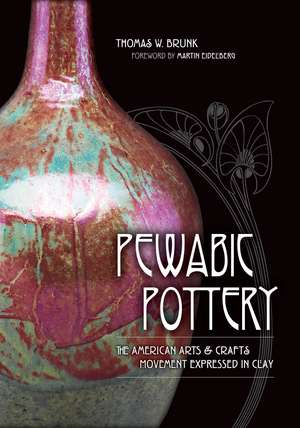Pewabic Pottery: The American Arts and Crafts Movement Expressed in Clay
Autor Thomas W. Brunk Cuvânt înainte de Martin Eidelbergen Limba Engleză Hardback – 30 apr 2021
Preț: 277.61 lei
Nou
Puncte Express: 416
Preț estimativ în valută:
53.12€ • 55.61$ • 43.95£
53.12€ • 55.61$ • 43.95£
Carte indisponibilă temporar
Doresc să fiu notificat când acest titlu va fi disponibil:
Se trimite...
Preluare comenzi: 021 569.72.76
Specificații
ISBN-13: 9781611863864
ISBN-10: 1611863864
Pagini: 496
Ilustrații: 219
Dimensiuni: 178 x 254 x 33 mm
Greutate: 1.29 kg
Ediția:1
Editura: Michigan State University Press
Colecția Michigan State University Press
ISBN-10: 1611863864
Pagini: 496
Ilustrații: 219
Dimensiuni: 178 x 254 x 33 mm
Greutate: 1.29 kg
Ediția:1
Editura: Michigan State University Press
Colecția Michigan State University Press
Recenzii
“Thomas W. Brunk has written the definitive history of Detroit’s Pewabic Pottery. A meticulous researcher, he carefully reconstructs the chronological narrative by mining previously unavailable documents, including glaze notebooks, daybooks, and letters.” —SUSAN J. BANDES, professor of art history and museum studies, Michigan State University, and author of Mid-Michigan Modern: From Frank Lloyd Wright to Googie
Notă biografică
THOMAS W. BRUNK (1949–2018) was curator and archivist of Michigan State University’s Pewabic Pottery from 1974 to 1981 and cofounder of the Pewabic Society Inc. in 1979, serving as its president in 1988–1989. He was considered Detroit’s foremost chronicler of subjects such as Pewabic Pottery, the Scarab Club, and the Masonic Temple, among others.
MARTIN EIDELBERG is professor emeritus of art history at Rutgers University.
MARTIN EIDELBERG is professor emeritus of art history at Rutgers University.
Descriere
Pewabic Pottery is a significant manifestation of the international Arts and Crafts movement in Michigan. As art historian Martin Eidelberg points out in his introductory essay, it was also a striking example of the coterie of talented American female ceramists who broke with traditional norms, seeking to excel both as artists and as entrepreneurs. This chronological history of Pewabic work—the most extensive study published to date—focuses primarily on the pottery as operated by Perry and Caulkins, and then up through the beginning of the Pewabic Society Inc. in 1979. Authored by the most recognized scholar on Pewabic Pottery, this study relies heavily on archival sources to achieve a comprehensive history of one of Michigan’s most interesting art studios.
